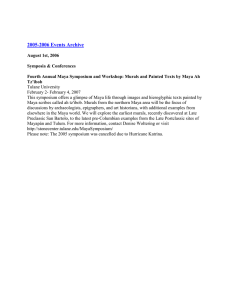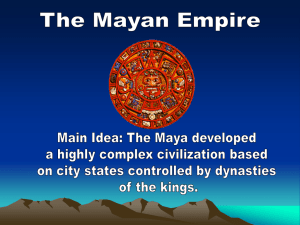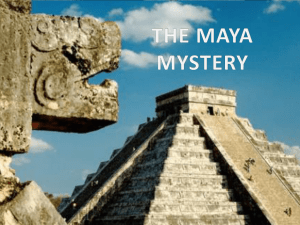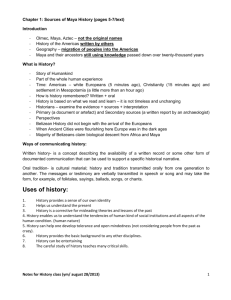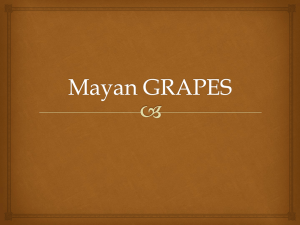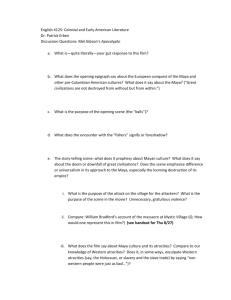The Rise of Maya Civilization
advertisement
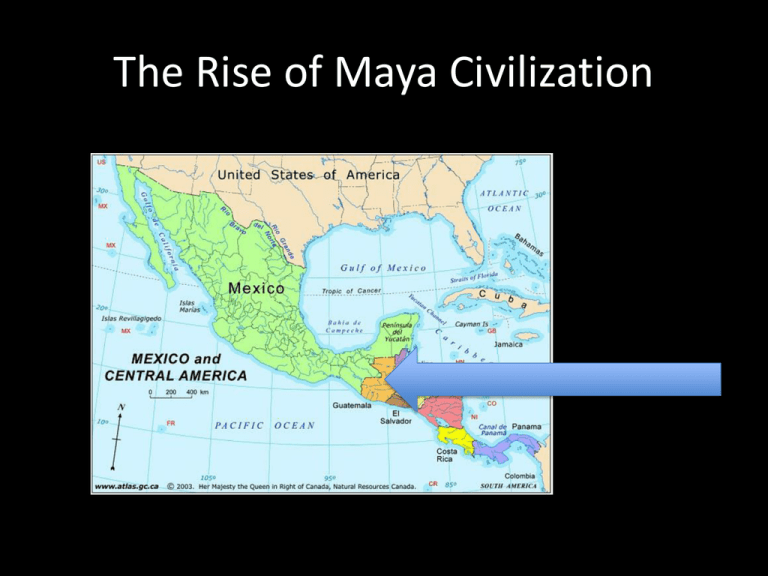
The Rise of Maya Civilization Building a Civilization in the Rain Forest 2.1 A Challenges of the Rain Forest • The classic Maya settled in the Yucatan Peninsula in modern-day Guatemala, Belize, El Salvador, Honduras, SE Mexico • Dense rainforest covered much of the land and made farming difficult • Climate was hot, dry, humid Challenges Contd. • Depended on seasonal rainfall for water • Rain soaked through limestone bedrock, leaving little surface water City Centers • Built immense ceremonial centers/city states at different sites • At Tikal, built temple one , a 130 ft. high step pyramid. • Several city states, not one united country Classic Maya Adaptations • Successfully farmed in the rain forest by: – using slash and burn agriculture. – Raised fields – Irrigated gardens • Planted and harvested corn, squash, and beans. • Mayan Families spread out – learned to cooperate in food production Maya Social and Political Organization 2.1 B Lord •Considered a godking •Responsible for political leadership •Lords, mostly men, •Women had great influence on political decisions Nobles •Lived near ceremonial centers and helped lords run cities •Gathered taxes, supplies, and labor for construction projects •Served as war captains who led peasant armies during war Priests •Were powerful because they maintained favor with the gods. •Led religious rituals, calculated positions of stars, and treated the sick •Practiced human sacrifice on a limited scale Merchants/ Artisans •Merchants traded salt, cotton, fish, and animal skins for obsidian , jade, quetzal feathers, copal, and cocoa beans over long distances • Artisans produced sculptures, codices, and murals to pay tribute to gods Peasants •Men worked in fields •Women managed household •Rewarded for their loyalty by being allowed to attend royal marriages and important religious ceremonies Slaves •Recruited from surplus children, war prisoners, and criminals •Required to do difficult or undesirable tasks like grinding maize •Not badly treated, but were sometime killed and buried with master Noteworthy Achievements of the Maya 2.1 C Legends • Legends were recorded on stelae, urns, murals, and codices • No Classic Maya literature survives, but legends in Popol Vuh, the mayan creation myth. Hieroglyphics • Only native American people to develop a complete writing system • Represented ideas and objects with block like symbols or glyphs. Architecture • Structures not as massive as in other cultures • Notes for its decorative stone work, graceful statues, intricate facades, and ornamental roofs • Distinctive feature was the corbeled arch How Do We Know? Mathematics • Sophisticated number system based on units of twenty, written with bars for 5s, dots for 1s, and sign for 0. Astronomy • Had exact knowledge of moon phases • Able to predict eclipses of the sun and moon Tikal, Guatemala http://www.tikalpark.com/soundsbirds02.html Calendars • Religious obsession with time for predicting future led to development of calendars • Calendars were complex systems using several interlocking cycles of time. Ball Game • Splendid courts still stand at many Maya sites (e.g. Tikal) • Game played both for recreation and religious purposes. Solving the Mystery of the Lost Maya Copan’s Glyph – a leaf-nosed bat! Tikal Copan The Calendar Wheels: Used for Astronomical Predictions • Vague Year: 365 days – 18 months , 20 days per month – 5 leftover days, no leap years • Sacred Round: 260 day year – Cermonial – Based on the length of time a woman is pregnant – Based on 1-13 repeating with 20 day names in two interlocking wheels


